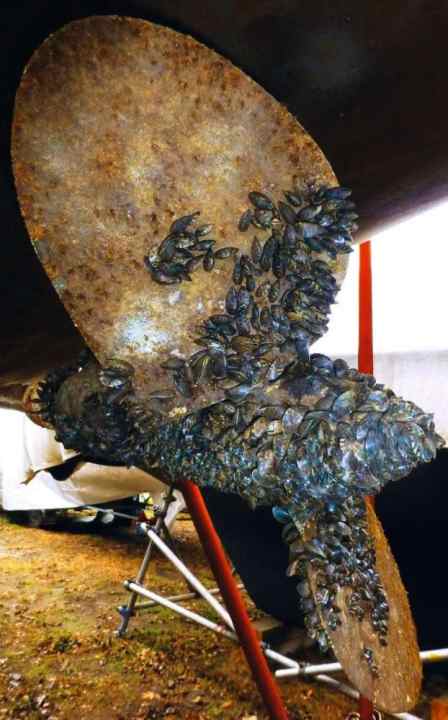
At present, the purchase and operation of a recreational boat is not so much determined by emotional factors, but increasingly byrational arguments crucial. Nevertheless, the owner should also be a little proud of thePerformance capability of his boat and have fun at higher speeds.
To ensure that this is the case, theConsequences and effects The effects of dirty underwater hulls and propellers covered in algae and mussels on the performance of a motor yacht can be demonstrated. This involves both theMaintaining the value of the boatand - and this is certainly more important - the impact on the environment, the increased operating costs and the reduction in travelling speed.

Years ago, a driving report byBOOTE (6/2000) on the same topic:
"However, the journey across the Adriatic to Rovinj ended in failure. The Rio, a100% gliderremained a displacer even at full throttle, gliding was out of the question."
This is certainly a consequence of the unclean underwater hull and propeller, and the issue is also of particular interest to commercial shipping. ManyResearch project to determine resistance of different colour smoothnesses and their possible fouling were investigated experimentally and theoretically.

For example, the Potsdam Shipbuilding Research Centre has a special test rig forFriction measurementsto determine the different drag coefficients. The results show that fouling increases the overall drag of cargo ships - and this also applies to motor yachts - byincrease by up to 50 % (!) can.
It is generally known that the fouling and growth of algae, mussels and other organic and inorganic components on the underwater hull depend on the water quality. There are different problems in fresh water than in seawater. The water temperature and salt content, as well as industrial pollution or over-fertilisation of the sea through agriculture, but also the incidence of light (sunny side) are just a few examples of this.
A particular phenomenon occurs in the waters of Berlin, for example: There, calcification of the surface of propellers can be expected after just a few months, which has a negative effect on the efficiency of the drive.
Much more aggressive in terms of performance reduction is the rough surface condition of propellers and underwater hull caused by mussels or barnacles, which can reach a considerable size and thickness. Unfortunately, even a protective coating cannot completely prevent fouling.
Surprisingly, barnacles are very firmly attached to the propeller and remain attached to the metal even at higher speeds. The only thing that helps here is mechanical cleaning by hand.
It is not without good reason that the boat stands in many marinas in the USA and certainly in other countries are equipped with a lift. This means that the underwater hull and drive of the motor yachts are above the surface of the water when not in use. Smaller motorboats are often also lifted up after each use and stored on land.
Frictional resistance
The most important drag components of the hull around which the water flows include frictional drag and residual drag, which mainly consists of wave drag. At low boat speeds, the share of wave resistance plays only a minor role.
Above all, we must endeavour to reduce frictional resistance, the extent of which depends on the surface quality of the underwater hull. Only at higher boat speeds, especially close to hull speed, does the wave resistance component increase disproportionately and far outweigh the frictional resistance.
In planing mode, the latter in turn is of decisive importance for the performance of the motor yacht.
Whether in displacement or planing mode, the frictional resistance increases with the square of the speed. With the help of a coefficient of friction (CF), which has been determined in many studies with a smooth surface and different roughness depths, the proportion of frictional resistance can be calculated using the following values:
► Size of the area of the wetted underwater hull
► Boat speed
► Running length of the current on the underwater hull
► Surface condition of the underwater hull (depth of roughness, coefficient of friction: CF)
► Kinematic viscosity of the water
In various test series on different body shapes, it has been proven that the drag coefficient can double or more with increasing roughness (fouling). Contamination has a particularly unfavourable effect in the foredeck area. What are the causes of this?
The boundary layer
A "laminar" and then a "turbulent boundary layer" forms on the body surface of the submarine over a very short foreship area. This layer becomes thicker the longer the length of the run. The laminar boundary layer is particularly thin, the streamlines run directly along the surface of the boat and cannot cover any unevenness.
The same applies to the first few metres of the turbulent boundary layer. This area of the underwater hull should therefore be as smooth as possible. Experts speak of "hydraulically smooth" surfaces. If you run your finger lightly over the surface and do not notice any unevenness, this condition is largely fulfilled.
Performance losses with displacers
Enough theory! Using the example of a motorboat with a waterline length of 7.90 metres, which is sailing as a displacer, we will show the effects of fouling. To determine the coefficients of friction and the permissible roughness, a hull speed of 5 knots is selected.
Taking these assumptions into account, average roughness depths of 0.03 mm (3/100 mm - and even less in the foredeck area!) must not be exceeded on the smooth underwater hull. This requires a very smooth outer skin.
If the permissible roughness depth is increased to an average of one millimetre, the proportion of frictional resistance doubles. Even with this relatively small increase in surface roughness, a loss of speed of around 0.8 knots must be expected. This does not take into account an (albeit small) deviation in the residual resistance.
Far greater losses must be expected if there are greater roughness depths and unevenness. As already explained, this applies in particular to the front area of the underwater hull. It is therefore worth ensuring that the surface is smooth.
Frictional resistance for planing boats
At high boat speeds in full planing condition, the frictional resistance in most cases significantly outweighs the residual resistance. The quality of the surface is therefore of paramount importance - even if the proportion of the wetted underwater hull is lower than with the displacer.
Irrespective of this, it should be remembered that the frictional resistance increases with the square of the boat speed and rises particularly sharply at high speeds. If the roughness depths described above are taken into account when gliding, this results in much higher travelling losses than with the displacer.
Since the wetted surface of the underwater hull of planing boats varies greatly, generalised information on this is not very meaningful.
One exception should also be mentioned. Laminar flow forms on struts, shaft brackets and the like with a very short run length; their separation when leaving the body causes increased resistance. A rough surface is therefore desirable in this exceptional case, which triggers a turbulent boundary layer and restricts the separation area.
A well-known example of this is the surface of a golf ball, which has indentations. If it were smooth, the golf ball would only fly a shorter distance precisely because of the laminar separation of the flow shown here.
Surface finish of the propeller
All the performance losses discussed so far due to fouling on the underwater hull only apply if the propeller is still bare and is not also affected by fouling. Unfortunately, the consequences of fouling on the propeller blades are particularly long-lasting, as the thrust (propeller efficiency) is reduced at the same time.
If roughness on the underwater hull and propeller is not taken into account, serious limitations in the performance of boats are unavoidable. Tests in the cavitation tank have shown that even relatively small deposits on the propeller blade can cause a loss of thrust of up to 30 %.
The leading edge and suction side areas are particularly sensitive here. Assuming the same conditions as described above, this leads to an additional loss of speed of 0.6 knots for a displacer.
This means that at a basic speed of 5 knots, a loss of speed of up to one and a half knots must be expected for the fouling on the underwater hull and propeller. To compensate for this, the propeller speed and propulsion power must be increased accordingly. This, in turn, is at the expense of economy and also has a greater impact on the environment.
Massive pox growth is fatal for the efficiency of a propeller. It can cause the thrust to almost completely collapse because no or only very little lift is generated on the blade. Anyone who has ever caught seaweed or similar on a propeller will know this problem from their own experience.
To reduce frictional resistance on body surfacesVarious measures are being discussed and trialled for surfaces that are already hydraulically smooth. The sharkskin is known as a carrier of a water film on the surface. In this case, the friction takes place between the film and the surface flow, which actually reduces the frictional resistance.
This phenomenon was created on boats with the help of films. However, the method did not prove successful, as the microscopically small pores clogged up very quickly, unlike sharkskin.
In another procedure, the so-calledAirstep technologyair particles are channelled under the bottom of the boat. This method can also reduce the amount of friction, as the air particles channelled into the boundary layer cause less frictional resistance than a turbulent boundary layer of solid water.
The new AIDA cruise ships are also to be equipped with a ventilation system. It is hoped that this will make them more economical and environmentally friendly.
Finally, research and industry are constantly developing new applications (paints, coatings, films, etc.) that prevent fouling but are also environmentally friendly and reduce frictional resistance to a minimum.

